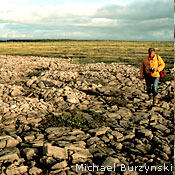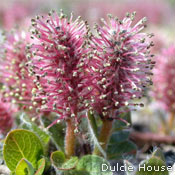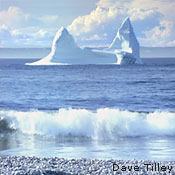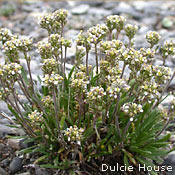The calcareous barrens in the Watts Point Ecological Reserve support a unique variety of rare and endangered plants.

- How to get There
- Activities
- Maps
- Services
- Fees and Schedules
- Rules and Regulations
- Permits
- Other Resources
- Contact Information
Located near the tip of Newfoundland’s Great Northern Peninsula, this 30.9-km2 parcel of land stretches almost 7 km along the Strait of Belle Isle-which in many years is packed with ice from December through June.
Together, the area’s combination of geology and climate yield conditions that foster a rare variety of arctic-alpine plants. Some of these plants occur only on the east and west coasts of North America, some have ancient affinities with European flora, and a few are found only in nearby locations in Newfoundland.
Watts Point Ecological Reserve lies within the Strait of Belle Isle Barrens ecoregion (762 KB). The flat coastal areas typical of the ecoregion have a thin vegetation cover that includes dispersed mats of Crowberry over calcareous gravel and bedrock. There are few trees or tall shrubs.
The appearance is desolate, yet a closer look reveals tiny arctic plants that grow in the rock and soil. The harsh local climate, strong winds, and frost action are all good for these species, which are relicts of the flora that appeared following the retreat of the last glaciers.

Plant species in the reserve that are found nowhere else in the world but on the Northern Peninsula include the endangered (COSEWIC, 2001) Barrens Willow (Salix jejuna) and the threatened (COSEWIC, 2000) Fernald’s Braya (Braya fernaldii). The reserve’s main terrace area also has patches of herbs such as Purple Mountain Saxifrage and stunted, wind-pruned shrubs.
Because of the reserve’s unique flora, it is often the scene of intensive research. In fact, the reserve was created to provide protection for the plants and for scientific research and educational touring purposes.
Watts Point was designated a provisional ecological reserve in 1986 and received full ecological reserve status in 1990.
How to get there
From Deer Lake and the Trans-Canada Highway, Watts Point is about 340 km up Newfoundland’s Northern Peninsula on Route 430. St. Anthony is about 80 km further along.
An abandoned highway 7 km north of Eddies Cove leads to the reserve. Users can also access the reserve by traveling south along the same abandoned road from Route 435, 7 km south of Cook’s Harbour. The road is in rough shape with several washouts so access is limited.
Off-road vehicles, including ATVs and snowmobiles, are prohibited in the reserve.
Activities

Scientific research is the main activity that takes place in the reserve. For more information and research guidelines, see Science and Research.
Off-road vehicles, including ATVs and snowmobiles, are not allowed in the reserve.
Hunting and fishing are permitted in the reserve, in the appropriate seasons and with valid licences.
Camping and building a fire is prohibited in the reserve.
Services
There are no services in the reserve.
Fees and Schedule
There are no fees involved in obtaining scientific research, commercial operator or educational tour permits.
Rules and Regulations
Biodiversity protection and habitat conservation are two of the key purposes of ecological reserves, so certain rules apply within all the reserves in the province.
The public can visit most ecological reserves for educational purposes or low-impact recreational activities, such as hiking or sightseeing. This is true at Watts Point, although because of the rare plants’ vulnerability, visitors are asked to be careful and watch their step.
The following activities are strictly prohibited in all wilderness and ecological reserves:
- Disturbing, destroying, or removing plants, animals, or fossils
- Introducing plants, animals, or anything else to the reserve landscape
- Forestry, mining (including exploration), hydro development, agriculture, new roads, tracks, or building construction
- Driving off-road vehicles including all-terrain vehicles (ATVs)
At the Watts Point Ecological Reserve:

- No entry permit is required, though visitors are asked to avoid walking on the tiny arctic-alpine plants while in the reserve.
- Because of the vulnerability of the plants, camping and building fires are not permitted in the reserve.
- Taking seeds, seedlings, or plant cuttings is prohibited.
Read the official reserve regulations:
- Botanical Ecological Reserve Regulations
- Watts Point Ecological Reserve Order
- Wilderness and Ecological Reserves Act
Adobe® Acrobat® Reader software can be used for viewing PDF documents. Download Acrobat® Reader for free
